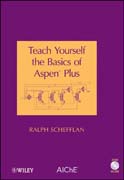
INDICE: PREFACE. 1 INTRODUCTION TO ASPEN PLUS. 1.1 Starting Aspen Plus. 1.2Graphic Users Interface. 1.3 Next Button. 1.4 Setup Specifications Display. 1.5 Simulation Options. 1.6 Units. 1.7 Components. 1.8 Properties. 1.9 Streams.1.10 Blocks. 1.11 Viewing Results. 1.12 Object Manager. 1.13 Plotting Results. References. 2 PROPERTIES. 2.1 Pure Component Data Banks. 2.2 Property Analysis. 2.3 Property Estimation. COPYRIGHTED MATERIAL. 2.4 Workshops. References. 3 THESIMPLEBLOCKS. 3.1 Mixer/Splitter Blocks. 3.1.1 Mixer Block. 3.1.2 Fsplit Block. 3.2 Simple Separator Blocks. 3.2.1 Sep Block. 3.2.2 Sep2 Block. 3.3 Some Manipulator Blocks. 3.3.1 Dupl Block. 3.3.2 Mult Block. 3.4 Workshops. 4 PROCESSES WITH RECYCLE. 4.1 Blocks with Recycle. 4.2 Heuristics. 4.3 Workshops. References. 5 FLOWSHEETING AND MODEL ANALYSIS TOOLS./b> 5.1 Introduction to Fortran in Aspen Plus. 5.2 Basic Interpreted Fortran Capabilities. 5.2.1 Primary Fortran Operators. 5.2.2 Precedence of Calculations. 5.2.3 Statement Format. 5.2.4 Program Logic Control. 5.3 Sensitivity Function. 5.4 Design Specification. 5.5 Calculator Function. 5.6 Transfer Function. 5.7 Workshops. References. 6THE DATA REGRESSION SYSTEM. 6.1 Parameters of Equations of State. 6.2 Parameters of Activity Coefficient Equations. 6.3 Basic Ideas of Regression. 6.4 Mathematics of Regression. 6.4.1 NewtonRaphson Method for Solution of Nonlinear Equations. 6.4.2 Direct Optimization of an Objective Function. 6.5 Practical Aspects of Regression of VLE or LLE Data. 6.5.1 Regression of VLE Data. 6.5.2 Regression of LLE Data. 6.6 Workshops. References. 7 FLASHES AND DECANTER. 7.1 Flash2 Block. 7.2 Flash3 Block. 7.3 Decanter Block. 7.4 Workshops. References. 8PRESSURE CHANGERS. 8.1 Pump Block. 8.2 Compr Block. 8.3 MCompr Block. 8.4 Pipelines and Fittings. 8.5 Workshops. Reference. 9 HEAT EXCHANGERS. 9.1 Heater Block. 9.2 Heatx Block. 9.3 Mheatx Block. 9.4 Workshops. References. 10 REACTORS. 10.1 RStoic Block. 10.2 RYield Block. 10.3 REquil Block. 10.4 RGibbs Block.10.5 Reactions for the Rigorous Models. 10.5.1 Equilibrium Class. 10.5.2 Powerlaw Class. 10.5.3 LangmuirHinshelwoodHougenWatson Class. 10.5.4 GeneralizedLangmuirHinshelwoodHougenWatson Class. 10.6 RCSTR Block. 10.7 RPlug Block. 10.8 RBatch Block. 10.9 Workshops. References. 11 MULTISTAGE EQUILIBRIUM SEPARATORS. 11.1 Basic Equations. 11.2 The Design Problem. 11.3 A Three-Product Distillation Example. 11.4 Preliminary Design and Rating Models. 11.4.1 DSTWU. 11.4.2 Distl. 11.5 Rigorous Models. 11.5.1 RadFrac. 11.5.2 Extract. 11.6 BatchSep. 11.7 Workshops. References. 12 PROCESS FLOWSHEET DEVELOPMENT. 12.1 Heuristics. 12.2 Example: The Production of Styrene. 12.3 A Model with Basic Blocks. 12.4 Properties. 12.5 Rigorous Flash and Decanter. 12
- ISBN: 978-0-470-56795-1
- Editorial: John Wiley & Sons
- Encuadernacion: Rústica
- Páginas: 216
- Fecha Publicación: 07/01/2011
- Nº Volúmenes: 1
- Idioma: Inglés
